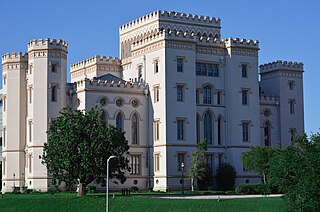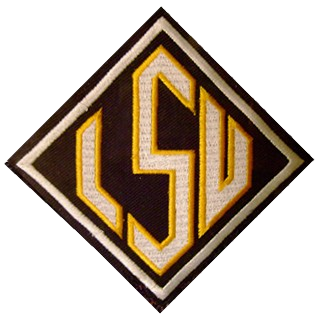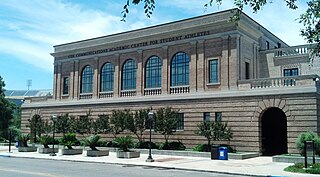
Baton Rouge is the capital city of the U.S. state of Louisiana. Located on the eastern bank of the Mississippi River, it had a population of 227,470 as of 2020; it is the seat of Louisiana's most populous parish (county-equivalent), East Baton Rouge Parish, and the center of Louisiana's second-largest metropolitan area and city, Greater Baton Rouge.

Louisiana State University is an American public land-grant research university in Baton Rouge, Louisiana, United States. The university was founded in 1860 near Pineville, Louisiana, under the name Louisiana State Seminary of Learning & Military Academy. The current LSU main campus was dedicated in 1926 and consists of more than 250 buildings constructed in the style of Italian Renaissance architect Andrea Palladio, occupying a 650-acre (260 ha) plateau on the banks of the Mississippi River.

Tiger Stadium, popularly known as "Death Valley", is an outdoor stadium located in Baton Rouge, Louisiana, on the campus of Louisiana State University. It is the home stadium of the LSU Tigers football team. Prior to 1924, LSU played its home games at State Field, which was located on the old LSU campus in Downtown Baton Rouge.
The Reveille, formerly the Daily Reveille, has been since 1887 the student newspaper at Louisiana State University in Baton Rouge, Louisiana. It prints twice a week on Mondays and Thursdays during the fall and spring semesters, and once a week on Monday in the summer. It publishes online content daily at LSUReveille.com. The Reveille has a weekly circulation of about 6,000 copies.

The LSU Tigers and Lady Tigers are the athletic teams representing Louisiana State University (LSU), a state university located in Baton Rouge, Louisiana. LSU competes in Division I of the National Collegiate Athletic Association (NCAA) as a member of the Southeastern Conference (SEC).

The Louisiana State University Health Sciences Center New Orleans is a public university focused on the health sciences and located in New Orleans, Louisiana. It is part of the LSU System and is the home of six schools, 12 centers of excellence, and two patient care clinics. Due to Hurricane Katrina, the School of Dentistry was temporarily located in Baton Rouge but has since returned to its campus in New Orleans. As a public university, it mostly accepts residents of the state of Louisiana with the exception of combined M.D./Ph.D. students and also children of alumni.

Swine Palace is a non-profit professional theatre company associated with the Louisiana State University Department of Theatre in Baton Rouge, Louisiana. The theatre companies home is located in the Reilly Theatre on the campus of LSU.

The John M. Parker Agricultural Coliseum or John M. Parker Agricultural Center is a 6,756-seat multi-purpose arena in Baton Rouge, Louisiana. It hosts local sporting events, horse shows, livestock shows and concerts.

The Louisiana State University Tiger Marching Band is the marching band of Louisiana State University (LSU). The band has 325 members and performs at all LSU football home games, all bowl games, and away games.
Louisiana State University School of Music is a music school located on the northwestern side of the campus of Louisiana State University in Baton Rouge, Louisiana, United States. The school is part of LSU's College of Music & Dramatic Arts, which also includes the LSU School of Theater. The college includes over 100 faculty and staff, over 600 majors, and offers wide range of degrees and curricular concentrations.

George A. Caldwell, sometimes known as Big George Caldwell, was a Louisiana building contractor and state official. In the 1930s, during the Great Depression, he served as Superintendent for Construction at Louisiana State University, where he was known to "rake off 2 per cent of the cost of all building projects." Caldwell managed the construction of nine buildings on the campus as federal Public Works Administration (PWA) projects in Baton Rouge. These included the university library and the structures housing the dairying and physics departments.

LSU Tiger Trails is the alternative transportation system providing bus service for students, faculty, staff and visitors, both on and off the campus of Louisiana State University. The LSU transit system is operated by First Transit, under contract with LSU's Office of Parking & Transportation Services, formerly known as the Office of Parking, Traffic & Transportation. There are a total of 31 buses in the Tiger Trails fleet. During daytime operating hours, the transit system is capable of operating up to 21 buses during peak hours with three back-up, and six small buses for on demand service.

Louisiana State University is the flagship university of the state of Louisiana, United States. This article describes the traditions of the university.

Huey P. Long Field House, on the campus of Louisiana State University in Baton Rouge, Louisiana, was constructed in 1932. It was named for notable U.S. Senator and state governor Huey Long. The field house is considered the original student union and included a post office, ballroom, gymnasium and also featured the largest swimming pool in the United States at the time.

The LSU Cox Communications Academic Center for Student-Athletes, on the campus of Louisiana State University in Baton Rouge, Louisiana, is located in the Gym/Armory building. The building opened in 1930 and was completely renovated and reopened in 2002 to house the Academic Center for Student-Athletes.

The LSU Gym Armory building on the campus of Louisiana State University in Baton Rouge, Louisiana was completed in 1930.

The LSU Lady Tigers swimming and diving team represents Louisiana State University (LSU) in the Southeastern Conference in NCAA women's swimming and diving. The team competes at the LSU Natatorium in Baton Rouge, Louisiana.Rick Bishop is the head coach of the women's swim team. Drew Livingston is the head coach of the women's diving team.

The LSU Tigers swimming and diving team represents Louisiana State University (LSU) in the Southeastern Conference in NCAA men's swimming and diving. The team competes at the LSU Natatorium in Baton Rouge, Louisiana. Dave Geyer is the co-head coach of the men's swim team. Doug Shaffer is the co-head coach of the men's diving teams.
The "LSU Alma Mater" was written in 1929 by Lloyd Funchess and Harris Downey, two students who developed the original song and music because LSU's first alma mater was sung to the tune of "Far Above Cayuga's Waters" and was used by Cornell University. The band plays the "Alma Mater" during pregame and at the end of each home football game. Also, members of the band join arm-in-arm at the end of rehearsals, and at the conclusion of the game itself, on Saturday game days and sing the "Alma Mater" before leaving the practice facility or stadium, respectively.


















